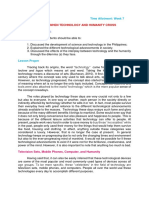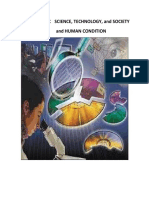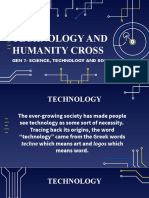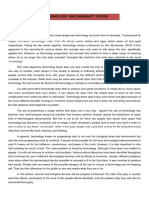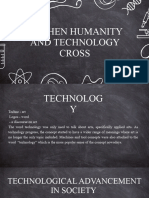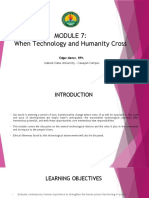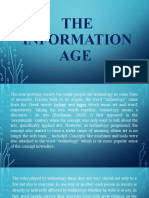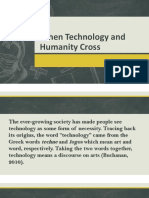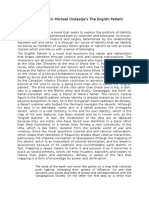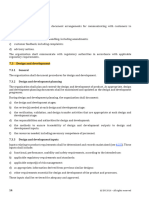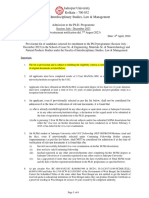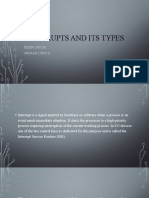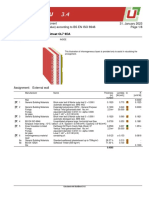Topic: WHEN TECHNOLOGY AND HUMANITY CROSS
LESSON OBJECTIVES
At the end of this lesson, the students should be able to:
• know the different technological advancements in society,
• discuss the development of science and technology in the Philippines,
• discuss the effects of the interplay between technology and humanity through the dilemma(s) they
face.
INTRODUCTION
The ever-growing society has made people see technology as some form of necessity. Tracing back its
origins, the word "technology" came from the Greek words techné and logor which mean art and word,
respectively. Taking the two words together, technology means a discourse on arts (Buchanan, 2010). It
first appeared in the seventeenth century where the concept was only used to talk about the arts,
specifically applied arts. However, as technology progressed, the concept also started to have a wider
range of meaning where art is no longer the only topic included. Concepts like machine and tools were
also attached to the word "Vechnology" which is the more popular sense of the concept nowadays.
The roles played by technology these days are very crucial not only to a few but also to everyone. In one
way or another, each person in the society is directly or indirectly affected by technology whether he
wills it or not. In fact, most people survive their everyday lives with great reliance to the different
technological advancements already available to the masses.
Technology these days enjoys such fame and glory because of the many different benefits it brings to
mankind. Some would even say that it does not only bring convenience but also pleasure and happiness
to people.
In general, technology keeps on progressing due to not only the changing times and environment but
also to the ever-progressing mind of mankind. It would not be possible for all these technological
advancements to exist if it were not for the brilliance, creativeness, and power of the mind. However, it
is also important to note that anything too much is bad.
� Television Sets, Mobile Phones, Computers, and Humanity
A number of technological devices can be easily found inside the home, the most accessible place to
anyone. Having said that, it can also be easily inferred that these technological devices are some of the
most popular and most commonly used types of devices across all age groups.
First, according to Kantar Media, one of the most trusted television audience measurement providers, in
the Philippines, 92 percent of urban homes and 70 percent of rural homes own at least one television
set. It is for this reason why television remains to be the ultimate medium for advertisement placements
(The Manila Times, 2014). In addition to this, Kantar Media also reported that in the Philippines, the
current count of households with television set already reached 15.135 million (Noda, 2012).
Television was a product of different experiments by various people. Paul Gottlieb Nipkow, a German
student, in the late 1800s was successful in his attempt to send images through wires with the aid of a
rotating metal disk. This invention was then called the "electric telescope" that had 18 lines of
resolution. After some time, in 1907, two inventors, Alan Archibald Campbell-Swinton who was an
English scientist and Boris Rosing who was a Russian scientist, created a new system of television by
using the cathode ray tube in addition to the mechanical scanner systern.
Second, Filipinos love to use their mobile phones anywhere, anytime. They use it for different purposes
other than for communication. More than half of the Filipino population own at least one mobile phone
regardless of type. In 2010, globai research agency Synovate conducted a survey and declared 67
percent product ownership in the country. In fact, it was also claimed that mobile phones are
considered a must-have among young Filipinos (ABS-CBN News, 2010). To prove that Filipinos really love
to use their mobile phones, the Ipsos Media Atlas Philippines Nationwide Urban 2011-2012 survey
results showed that one in every three Filipinos cannot live without a mobile phone.
Mobile phones have a very interesting background story. On April 3, 1973, Martin Cooper, a senior
engineer at Motorola, made the world's first mobile phone call. He called their rival telecommunications
company and properly informed them that he was making the call from a mobile phone. The mobile
phone used by Cooper weighed 1.1 kilograms and measured 228.6 x 127 x 44.4 mm. This kind of device
was capable of a 30-minute talk time. However, it took 10 hours to charge.
Lastly, computers and laptops have also become part of many of the Filipino households. There are
some Filipino families who own more than one computer or laptop while some own at least one
computer or laptop. However, the number of computers or laptops sold per year may not be as high as
the number of mobile phones and television sets.
Computers and laptops also have a long background bistory of trial and error, It was Charles Babbage, a
nineteenth-century English Mathematics professor, who designed the Analytical Engine which was used
as the basic framework of the corr puters even until the present time. In general, computers can be
classified into three generations. Each generation of the computer was used for a certain period of time
and each gave people a new and improved version of the previous one (Steitz, n.d.). The first true
portable computer was released in April 1981. It was called the Osborne 1 (Orfano, 2011).
�Here are some facts about Filipinos and their use of gadgets and the Internet (Rappler, n.d.):
* Mobile phone subscription is at 119 million.
* Filipinos spend approximately 3.2 hours on mobile and 5.2 hours on desktop daily.
* Currently, the Philippines has one of the highest digital populations in the world.
* There are now 47 million active Facebook accounts in the Philippines.
* The Philippines is the fastest-growing application market in Southeast Asia.
Roles Played by These Technological Advancements
Television sets, mobile phones, and computers or laptops all have different functions and roles played in
the lives of the people. For instance, television is mainly used as a platform for advertisements and
information dissemination, it also serves as a recreational activity and good stress reliever to most
families, specifically to Filipino families. Television also is a good platform for different propagandas and
advocacies.
Mobile phones, on the other hand, also have their own roles in the lives of the people. They are
primarily used for communication. Mobile phones offer services like texting and calling. It is like an all-in-
one device. In addition, it is very portable and convenient because it can fit into any space, may it be
inside the pocket or bag.
Personal computers and laptops also have useful set of functions and roles. Although most of the
functions found in these technological devices are now also available in mobile phones, they still offer
their own unique features that make them attractive. For example, personal computers and laptops can
be used to surf the Internet and communicate.
Ethical Dilemma Faced by These Technological Advancements
Most parents would argue that these devices make their children lazy and unhealthy. Another dilemma
faced by these technological devices is the moral dilemma. People, especially the children who are not
capable yet of rationally deciding for themselves what is right or wrong, are freely exposed to different
things on television, mobiles phones, laptops, or computers.
�Robotics and Humanity
Another great product of the innovative minds of the people is the robot. Robots are now widely used.
For example, there are the so-called service robots. The International Federation of Robotics (IFR) and
United Nations Economic Commission for Europe (UNECE) made it their task to formulate a working
definition for service robots. A preliminary extract of the relevant definition is (IFR, 2012):
• A robot is an actuated mechanism programmable in two or more axes with a degree of autonomy,
moving within its environment, to perform intended tasks.
• A service robot is a robot that performs useful tasks for humans or equipment excluding industrial
automation application. Note: A robot may be classified according to its intended application as an
industrial robot or a service robot.
• A professional service robot ot a service robot for professional use is a service robot used for a
commercial task, usually operated by a properly trained operator.
Germany was one of the first countries to develop service robots. As part of the German Federal
Ministry of Education and Research's "Service Robotics Innovation Lead Initiative," it sponsored a
collaborative project called DESIRE (Deutsche Servicerobotik Initiative-Germany Service Robotics
Initiative) which was launched on October 1, 2005. DESIRE has the following individual objectives
(DESIRE, 2009):
* To achieve a technological edge toward attaining key functions and components that are suited for
everyday use
* To create a reference architecture for mobile manipulation
* To promote the convergence of technologies through integration into a common technology platform
* To conduct pre-competition research and development activities for new products and technology
transfer in start-up enterprises in the field of service robotics
Some of the expected work to be performed by DESIRE are the following: (1) "Clear up the kitchen
table" all objects on top of the kitchen table will be inoved to where they belong; (2) "Fill the
dishwasher" the dirty dishes will be sorted correctly into the dishwasher, and (3) "Clear up this room" all
objects that are not in their proper places will be moved to where they belong (Mock, n.d.).
The earliest conception of robots can be traced around 3000 B.C. from the Egyptians. Their water clocks
used human figurines to strike the hour bells. However, the earliest robots as people know them were
created in the early 1950s by George Devol. "Unimate" was his his attempt to sell his product to the
industry did not succeed. After Unimate, several robots were also invented which were better versions
of the previous ones (Stanford, n.d.).
�Roles Played by Robotics
Robots play different roles not only in the lives of the people but also in the society as a whole. They are
primarily used to ease the workload of mankind. They were invented to make life more efficient and less
stressful.
Laws formulated by Isaac Asimov back in the 1940s, when he was thinking of the ethical consequences
of robots. These are the following (Stanford, n.d.):
Law One:
A robot may not injure a human being or, through inaction, 'low a human being to come to harm.
Law Two:
A robot must obey the orders given it by human beings except where such orders would conflict with
the First Law.
Law Three:
A robot must protect its own existence as long as such protection does not conflict with the First or
Second Law.
Ethical Dilemma/s Faced by Robotics
One of the dilemmas faced by robots is safety. Who should be held accountable if someone's safety is
compromised by a robot? Who should be blamed, the robot, the agent using the robot, or the
maker/inventor of the robot?
Another ethical dilemma faced by robots is the emotional component.
In the field of robotics, there are the so-called partial autonomy and full satonomy. Partial auconomy
includes active human-robot interaction while full autonomy excludes active human-robot interaction.
If the problems arise when the robot deviates from the laws specified, then the maker or the inventor of
the machine should be blameworthy It just means that the robot was not programmed very well
because it violated the laws. Other problems may arise when the machine develops the ability to think
for itself. In this case, the one that should be blame can both, be the maker or inventor and the robot
itself. This is because, in the first place, the maker gave the robot the capacity to think for itself so he
should be very much aware of its possible consequences.


